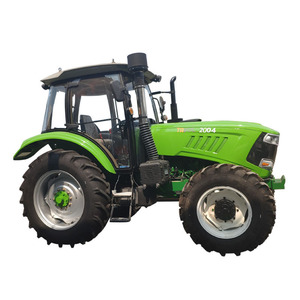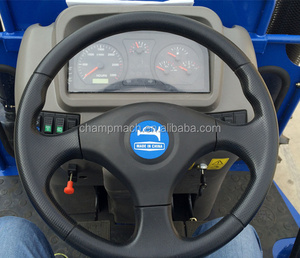(1163 products available)









































































































































































































Various types of Russian farm tractors are available for different agricultural and farming needs. Here is a detailed description of some of the most popular Russian tractors:
трактор-колесный
The wheel tractor, or ''Traktorl kollesny,'' is famous for its ability to perform different tilled field work operations and transportation tasks. It is designed with a robust engine and rubber tires. The wheel tractor provides farm users with a smooth and flexible ride across various terrains. It is an excellent choice for farm users who work on dry and moderately wet soils.
мини трактор
A mini tractor (''Traktorl mini'') is smaller and more compact than a standard tractor model. It works well in small-scale farming, vegetable cultivation, or vineyard maintenance. A mini tractor provides farm users with ease of maneuverability in tight spaces. Some models are designed with attachments like tillers, loaders, and mowers for more versatility.
трактор- гусеничный
Also known as the caterpillar tractor, the трактор-гусеничный (''Traktorl Gusenchiy'') is built with heavy steel tracks or ''gusi'' instead of wheels. This makes the tractor very suitable for farm work that requires heavy-duty operations, such as land reclamation, construction, or deep plowing. The tracks offer superior traction and weight distribution, allowing them to navigate challenging terrain with ease.
универсальный трактор
The universal tractor (''Traktorl Universaliy'') is engineered for multiple farm tasks, from plowing and planting to harvesting and hauling. Universal tractors usually come in different sizes and power ratings, allowing farm users to choose a model that best fits their farm's needs and size.
мощный трактор
A powerful tractor (''Moshny Traktor'') combines high horsepower and advanced technology to meet the demands of large-scale farming operations. It's designed with powerful engines and efficient transmission systems. A powerful tractor offers farm users the strength and performance they need to tackle even the most challenging farming tasks with ease.
трактор с прицепом
A tractor with a trailer (''Traktor s pritsepm'') is a versatile farm vehicle combination for transporting goods and materials. The tractor provides the power and traction, while the trailer offers ample cargo space. This combination is widely used in agriculture for transporting harvested crops, livestock, machinery, and other materials between fields and storage areas.
Tractor farm machines are designed to pull and rotate heavy implements. Most tractors are fitted with high-power diesel engines, and their energy output is measured in horsepower. The horsepower can range from 80 to over 600, depending on the model. For basic farm work like tilling and planting, tractors with 80 to 130 horsepower are sufficient. High-horsepower tractors between 130-200 are used for more demanding tasks such as harvesting and pulling heavy equipment. The largest models have farm tractor horsepower of over 600 and are used in large-scale commercial farms.
Russian tractor trucks usually have a 4WD or 2WD option, with the latter being more common. The two-wheel drive tractors are lighter and less expensive but not suitable for work on wet or muddy farms. The average weight of a farm tractor is about 1,500 kg, but larger models can weigh up to six tons. The tractor's overall dimensions vary depending on the model. A standard Russian tractor’s length is about four meters, its width is 2.5 meters, and the height is 2.5 meters. Narrower tractors are manufactured for orchards where rows of trees are closely spaced.
Like all diesel-engine tractors, Russian models require regular maintenance for farm work to be carried out without interruptions. Basic maintenance includes regularly servicing the air, fuel, and oil filters to ensure the engine breathes properly and burns clean fuel. Lubrication of moving parts is crucial, and this is made easier by the installation of grease fittings or ''zerks''.
A monthly inspection is essential for identifying emerging issues. During the inspection, look for signs of wear and tear, loose bolts, leaks in the hydraulic system, and damaged tires. The most critical component, the engine, should be inspected for wear and tear, leakages, loose parts, and corrosion. During inspections, the tractor should be cleaned to remove dirt and plant residue that may block air passageways and coolant channels.
Tire pressure should be checked after the tractor has been idle for a considerable time. The weight of the tractor can lower the tire pressure, increasing fuel consumption and wear and tear. Users should familiarize themselves with the manufacturer’s manual and follow the recommended maintenance schedule. Daily maintenance includes inspecting fluid levels like working fluids, lubricants, fuels, and oils. When using the tractor, avoid overloading fluid-carrying implements beyond the recommended limit.
Russia is a vast country with diverse topographies, making it both challenging and crucial to maintain efficient agricultural practices. Russian tractors are essential for various activities such as land preparation, planting, harvesting, and post-harvest operations. They are used for moving farm produce from one point to another as well as lifting and clearing of farm debris.
Due to its massive size, farm management would take a longer time if not for the presence of tractors. It has been estimated that with the use of tractors, managing farmland is made easier and efficient. In areas where the machine cannot be used, farm implements are pulled by tractors to ensure proper use of land.
Farmers working in rough terrain benefit from the technology used to create strong tires that can withstand any kind of weather. Tractors with powerful diesel engines ensure that all farm activities are-running smoothly.
In Russia, older models of tractors are still being used because they are easy to repair and agriculture professionals are familiar with their workings.
Recently, Russian farm tractors have been fitted with technology such as GPS systems that allow automated steering for greater accuracy while meanwhile bringing down labor costs and increasing efficiency on farms at the same time.
Consumer awareness regarding fuel consumption has made it imperative for companies to produce those kinds of Russian tractors that use less energy without compromising quality or output levels during any given hour spent out in the field working by livestock people who know about machinery like we do here.
In conclusion, despite facing several challenges over time like economic sanctions, there is still a high demand for Russian tractors among commercial farmers who rely heavily upon this machine's versatility coupled with ease-of-use from morning till night throughout the entire year-round farming season.
When purchasing used Russian tractors for sale, it's important to take stock of a number of things in order to fulfill the needs of the target consumers. Examine the following key tractor characteristics and their significance to the qualities of the target audience and market:
Land Mass and Dimensions Handled
Farm size is an important factor to consider. The horse power and physical dimensions of the tractor that would be required to effectively manage the target audience's farm areas is determined by this. For small-holder farmers with little farmlands, smaller tractors with lower horsepower are ideal. However, large-scale farmers with extensive farmlands will require more powerful tractors with more advanced technology and larger dimensions that can handle greater areas in their farms.
Core Farm Activities and Implements
Consideration should be given to the major farm operations for which the tractors are expected to be used, as well as the various attachments and tools required. Certain tractors are better suited for use in the cultivation of certain crops than others. For instance, deep tilling requires the use of large and powerful tractors. Also, farms with high-tech and specialized farm activities will require tractors that can be fitted with advanced and specialized implements.
Terrain and Accessibility
The kind of terrain and its dimensions would have an effect on the choice of tractor. For instance, hilly and rough terrains require tractors with enough horsepower to manage its roughness and topography, while properly demarcated and flat farmlands may need something less powerful and more cost-effective. Also, the kind of soil present on the farm will also affect the choice of tractor. For instance, marshy or muddy soils may require special tires for proper handling.
Technology Integration
Tractors now come equipped with technology such as GPS guidance, automation, and precision farming features that could enhance farm management. These technological integrations should be considered carefully when looking to purchase a tractor for precision farming or remote farm management.
Q1: Are there any technologies that help farmers safely transport the tractor to a farther location?
A1: Yes, some Russian tractors are equipped with train technologies or a roll bar to increase safety when transporting the tractor by train. With this technology, the tractor will be more secured on the train rail.
Q2: Are there air conditioners in farm tractors?
A2: Yes, almost all modern tractors have air conditioners to help the driver have more comfort during work.
Q3: What are the trends in farm tractor technology?
A3: Some current trends are the incorporation of AI programs to assist in automated driving, which gives a high level of precision, and remote-controlled tractors.
Q4: What is the lifespan of a Russian tractor?
A4: A well-maintained tractor can last between 10 to 15 years. However, with proper maintenance and care, a tractor could be used for up to 20-25 years.